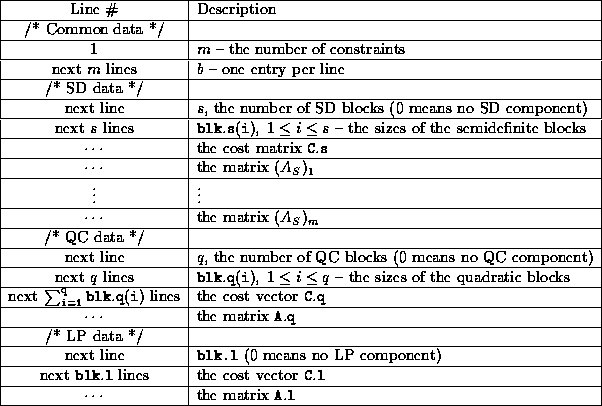



Next: Examples
Up: SDPpack User's Guide Version
Previous: References
In the User's Guide for SDPpack Version 0.8 Beta[8],
an ASCII storage
format for SDP was suggested, based on one communicated to us by
A. Nemirovskii. Here, we further extend this to represent SQL
problems. We essentially have two cases: the matrices
are (i) dense, or (ii) sparse, and in each case, the matrix
is represented in a different way. In all cases below, we store one
number per line in the file (so that the file may be read efficiently
using Matlab's load command), although the text sometimes shows
several entries on the same line for clarity.
- Semidefinite part
- We need to store the cost matrix
 as well as the constraint matrices
as well as the constraint matrices  ,
,  corresponding to the rows of the matrix
corresponding to the rows of the matrix  .
Suppose X is a block diagonal matrix with block structure
.
Suppose X is a block diagonal matrix with block structure
 . We respresent the ith diagonal block of
this matrix by X(i), and the (j,k) element within the ith
block as
. We respresent the ith diagonal block of
this matrix by X(i), and the (j,k) element within the ith
block as  .
.
- Case (i)
- For the first block, we first record a 0 (denoting
that the block is dense), and then the entries in the upper
triangular part of the matrix are provided row-wise.

(Similar segments for the remaining blocks  .)
.)
- Case (ii)
- For the first block, we first record a 1 (denoting
that the block is sparse), then the number of nonzero entries
in the upper triangular part of the block, say n. Then, for
 , we record the row number
, we record the row number  , the column number
, the column number
 , and the value of the corresponding nonzero entry
, and the value of the corresponding nonzero entry
 .
.

(Similar segments for the remaining blocks  .)
The row and the column indices are into the block, and not into the
whole matrix X.
.)
The row and the column indices are into the block, and not into the
whole matrix X.
Note: at present, the code does not permit mixing sparse and
dense matrix blocks: the blocks must be either all dense or
all sparse.
- Quadratic part
- Here, we need to store
the constraint matrix
 , which has m rows and
, which has m rows and  columns.
columns.
- Case (i)
- We first record a 0 if the
constraint matrix is dense. Then, the elements of the constraint
matrix are given column-wise.
- Case (ii)
-
We first record a 1 if the
constraint matrix is sparse, then the number of nonzero entries
in the matrix. Then, for each nonzero entry, we record the row number,
the column number and the value of the corresponding entry.
- Linear part
- Here, we need to store the
constraint matrix
 of size
of size  .
.
- Case (i)
- We first record a 0 if the
constraint matrix is dense. Then, the elements of the constraint
matrix are given column-wise.
- Case (ii)
- We first record a 1 if the
constraint matrix is sparse, then the number of nonzero entries
in the matrix. Then, for each nonzero entry, we record the row number,
the column number and the value of the corresponding entry.
In Table A, we describe the overall storage
format for an SQLP; matrices for each of the three parts (semidefinite,
quadratic and linear) are stored as just described. The C-style comments are
not a part of the storage format.

Table 2: ASCII storage format for SQLP's




Next: Examples
Up: SDPpack User's Guide Version
Previous: References
Madhu Nayakkankuppam
Wed Jun 25 18:01:54 EDT 1997

 .)
.)
 , we record the row number
, we record the row number  , the column number
, the column number
 , and the value of the corresponding nonzero entry
, and the value of the corresponding nonzero entry
 .
.

 .)
The row and the column indices are into the block, and not into the
whole matrix X.
.)
The row and the column indices are into the block, and not into the
whole matrix X.
